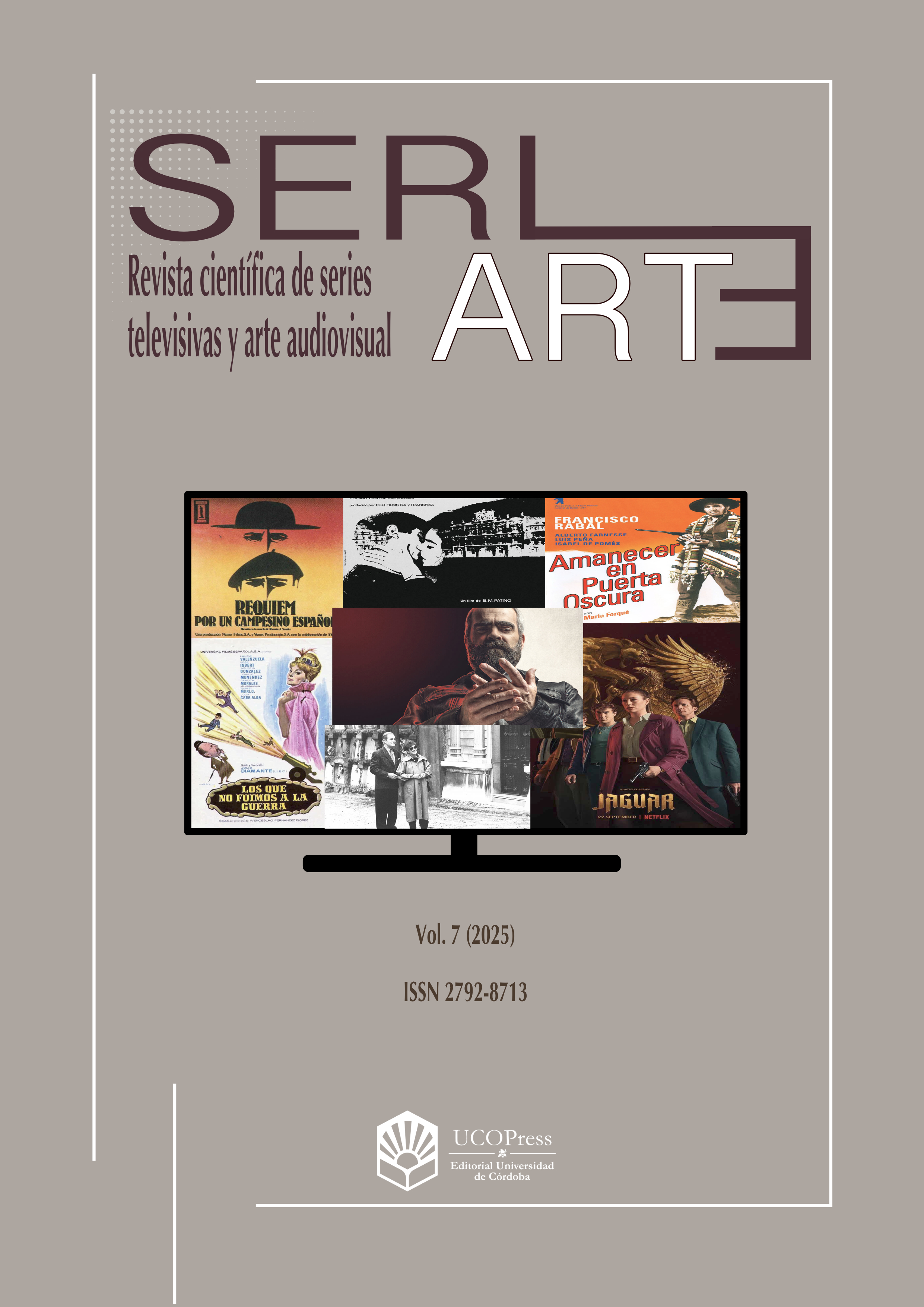"Streaming Noir": la evolución del thriller en las series españolas
Contenido principal del artículo
Resumen
A lo largo de las últimas décadas, el cine negro español ha ido evolucionando desde un cierto manierismo para emular a los thrillers norteamericanos hasta unos productos más autóctonos que, sin renunciar a la calidad en la factura de los mismos, tratan temas sociales más próximos a la audiencia. Paralelamente y como un efecto colateral de sumo interés, ello ha beneficiado sobremanera a las ficciones televisivas, las cuales han tomado esa fuente de inspiración con la ventaja de disponer de más horas para desarrollar a sus personajes y sus motivaciones que en el celuloide. Por ejemplo, el punto de inflexión que supuso la situación pandémica para el auge de las plataformas de streaming derivó en una verdadera proliferación de series nacionales (Nasdrovia, Patria, Antidisturbios, etc.) que aspiraban a culminar una revolución que ya se había ido gestando en los años anteriores. Nuestro análisis busca plantear una cronología para comprender mejor este fenómeno televisivo y, de igual manera, incidir en los contextos históricos e investigaciones periodísticas (en particular casos como Fariña de Nacho Carretero) que han justificado ese interés del público, fiel reflejo de las preocupaciones y temas de la más rabiosa actualidad (corrupción política, terrorismo, crimen organizado, etc.) del país.
Descargas
Datos de publicación
Perfil evaluadores/as N/D
Declaraciones de autoría
Indexado en
- Sociedad académica
- Seriarte. Revista científica de series televisivas y arte audiovisual
- Editorial
- Ucopress. Cordoba University Press
Detalles del artículo

Esta obra está bajo una licencia internacional Creative Commons Atribución-NoComercial-SinDerivadas 4.0.
Citas
ÁLVAREZ, Rafael y SIMON, David (2017), The Wire: Toda la verdad, Barcelona: Principal de los Libros.
BALMORI, Guillermo (ed.) (2019), Adictos al Crack, Madrid: Notorious Ediciones.
BARROSO, Mario (dir.) (2020), Blu-ray + Book: La línea invisible: Cuando ETA eligió matar, Valladolid: Divisa Home Video.
BOYERO, Carlos (2024), Carlos Boyero: No sé si me explico, Madrid: Espasa.
CARRETERO, Ignacio (2015-2018), Fariña, Madrid: Libros del K.O.
CASCAJOSA, Concepción (ed.) (2015), Dentro de El Ministerio del Tiempo, Madrid: Léeme Libros.
CASTELLÓ, Iván (2017), Salvaje: La imperiosa historia de Jesús Gil y Gil, Barcelona: Contra.
CORREAL, Francisco (2010), «Paco Pérez Gandul: a la cárcel por una novela», El Día de Córdoba, 14 de febrero. En: https://www.eldiadecordoba.es/ocio/Paco-Perez-Gandul-carcel-novela_0_341965874.html
CRISÓSTOMO, Raquel y ROS, Enric (coords.) (2015), Mad Men o la frágil belleza de los sueños en Madison Avenue, Madrid: Errata Naturae.
DOMÍNGUEZ, Iñaki (2020-2022), Macarras interseculares: Una historia de Madrid a través de sus mitos callejeros, Madrid: Editorial Melusina.
DOMÍNGUEZ, Íñigo (2019), Paletos salvajes: Crónicas de la Mafia II, Madrid: Libros del K.O.
GALIACHO, Juan Luis (2022), «La vida de Los Miami: El clan que dominaba la noche de Madrid desvelado por El Cierre Digital», El Cierre Digital, 2 de noviembre. En: https://elcierredigital.com/investigacion/294611040/vida-los-miami-clan-dominaba-noche-madrid-serie-inmortal-movistar.html
GARCÍA MARTÍNEZ, Alberto Nahum y ORTIZ, María Jesús (eds.) (2018), Cine & Series: La promiscuidad infinita, Salamanca: Comunicación Social.
GREENE, Richard y VERNEZZE, Peter (2010), Los Soprano y la filosofía, Barcelona: Ariel.
GUIRAL CONTI, Antoni (2018), El universo de Ibáñez: De 13 Rue del Percebe a Rompetechos, Barcelona: Bruguera.
IMPERIOLI, Michael, LERMAN, Philip y SCHIRRIPA, Steve (2021), The Definitive Oral History of the Sopranos: Woke Up This Morning, New York: HarperCollins.
LEHDER RIVAS, Carlos (2024), Vida y muerte del Cartel de Medellín, Barcelona: Debate.
LOAIZA, Fonsi (2022), Florentino Pérez: El poder del palco, Madrid: Akal.
LÓPEZ QUESADA, Álvaro (2022), «Suburra: La serie como resultado de un proceso transmedia», SERIEARTE: Revista científica de series televisivas y arte audiovisual, vol. 2, julio, pp. 95-107. https://doi.org/10.21071/seriarte.v2i.14565 DOI: https://doi.org/10.21071/seriarte.v2i.14565
LOZANO, Andros (2024), Costo: Las leyes del Estrecho, Madrid: Libros del K.O.
LUQUE CARRERAS, José Antonio (2022), El cine negro español, Madrid: T & B Editores.
MARTÍNEZ, Luis (2019), «Jesús Gil, miedo y asco en España», El Mundo, 8 de julio. En:https://www.elmundo.es/papel/firmas/2019/07/08/5d2202fdfc6c83556c8b469b.html
MEMBA, Javier (2020), El cine negro español: Del spanish noir al policiaco actual, Madrid: Ediciones JC.
MITTELL, Jason (2015), Complex TV: The Poetics of Contemporary Television Storytelling, New York: NYU Press.
ORDOVÁS, Jesús y GODES, Patricia (2020), Guía del Madrid de la Movida, Madrid: Anaya.
ORTUÑO, Almudena (2015), «¿Dónde está Misent?», Valencia Plaza, 13 de diciembre. En: https://valenciaplaza.com/donde-esta-misent
PALACIO, Manuel (2024), La televisión en España (1990-2022): Sociedad y cultura, Madrid: Cátedra.
PALAZÓN, Miguel (2019), «Los Miami: Matones españoles que controlaban discotecas y tráfico de drogas», COPE, 19 de enero. En: https://www.cope.es/actualidad/sociedad/noticias/los-miami-matones-espanoles-que-controlaban-discotecas-trafico-drogas-20190119_174759
PÉREZ MARTÍN, Javier (2023), Aquí no hay quien viva: Detrás de las cámaras: la delirante historia de esta nuestra comunidad, Barcelona: Plaza & Janés.
SALAS RABANEDA, Andrés (2024), «Cómo triunfar sin remordimientos», Cinemanía, n.º 344, mayo, p. 127.
SAVIANO, Roberto (2014-2017), Gomorra, Barcelona: Debolsillo.
SILIÓ, Elisa y GONZÁLEZ URBANEJA, Fernando (2004), «La telebasura. Telebasura, un concepto confuso», Escritura pública, n.º 29, pp. 38-41.
SIMON, David y BURNS, Ed (2021), La esquina: El año que David Simon pasó en las trincheras del negocio, Barcelona: Principal de los Libros.
SOL, Bruno (coord.) (2016), «Street Fighter II», Retro Gamer: La publicación definitiva sobre videojuegos clásicos, n.º 15, abril, pp. 8-17.
SOROGOYEN, Rodrigo y PEÑA, Isabel (2020), El Reino. Guion cinematográfico, Madrid: Ocho y Medio.
SOTO FERNÁNDEZ, Gloria (2023), «La era del consumo en la esfera audiovisual: series y plataformas streaming», SERIEARTE: Revista científica de series televisivas y arte audiovisual, vol. 3, enero, pp. 102-123. https://doi.org/10.21071/seriarte.v3i.15199 DOI: https://doi.org/10.21071/seriarte.v3i.15199
TRAPIELLO, Andrés, El Rastro: Historia, teoría y práctica, Barcelona: Ediciones Destino.
WAINWRIGHT, Tom (2017), Narconomics: Cómo administrar un cártel de la droga, Debate: Villatuerta.
ZOLLER SEITZ, Matt y SEPINWALL, Alan (2019), The Sopranos Sessions, New York: Abrams Press.






